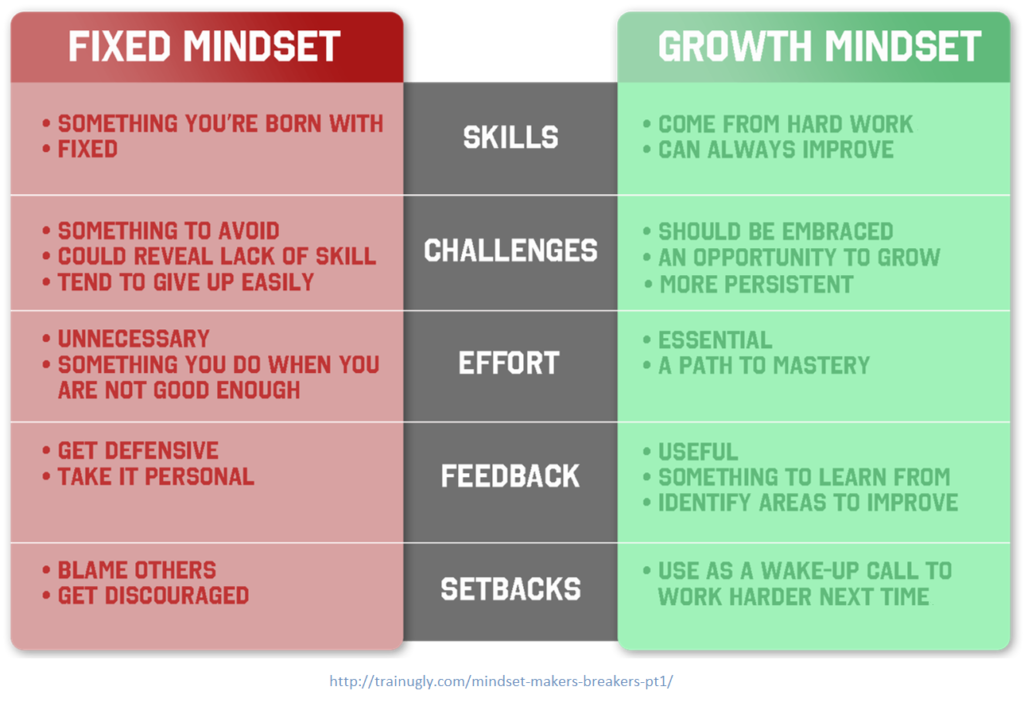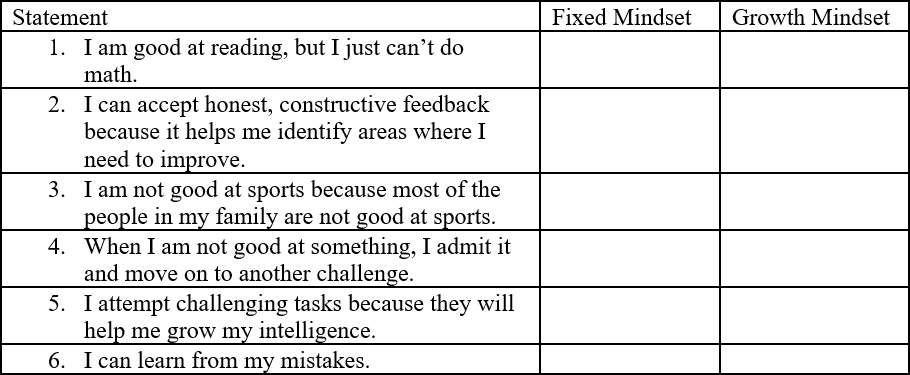Part 1: Teaching Students What Self-Efficacy Is and Why It Is Important
Part 2: Helping Students Understand Their Strengths and Challenges in Self-Efficacy
Part 3: Approaching Challenges With a Growth Mindset
- Teach Students: 3a. Fixed vs. Growth Mindset
- Teach Students: 3b. What’s My Mindset?
- Teach Students: 3c. Brain Basics
- Teach Students: 3d. Reflecting on Self-Efficacy
Part 4: Embedding Opportunities for Students to Practice Self-Efficacy
Part 5: The College and Career Competency Framework
Part 3: Approaching Challenges With a Growth Mindset
Learning Target: Students can differentiate between fixed and growth mindset and can describe how the brain changes when you learn or practice skills.
In Part 3, you will learn more about how to support students in focusing on their effort, progress, and learning. When students learn to apply the first component, it builds their self-efficacy. The next set of activities will support students in understanding the difference between a fixed and growth mindset, as well as understanding how the brain changes when we learn new things or practice concepts that we don’t fully understand.
Let’s start by taking a closer look at what it means to have a growth mindset. A person’s beliefs about learning have a substantial impact on their success. People who believe that they can grow their intelligence are said to have a growth mindset. When people believe that our intelligence and abilities are set, they have a fixed mindset. Research has shown that people with a growth mindset persist longer and are more accepting of challenges than those with a fixed mindset. People with a growth mindset also learn more quickly than those with a fixed mindset (Ragan, 2015; Yeager, et al., 2019).
Teach Students: 3a. Fixed vs. Growth Mindset
Explain to students that they will learn how to differentiate between a fixed and growth mindset and that they will also learn some basic facts about neuroscience (the study of the brain) that explain how putting in effort actually changes the physical structure of the brain. We will start by learning the difference between a fixed and a growth mindset.
Show students this video of McKenzie explaining fixed and growth mindset. As students are watching the video, ask them to use the following questions, found on the “Teach Students: 3a. Fixed vs. Growth Mindset” handout (Handout 3a. linked to on page 11 of your Educator Workbook) to identify key concepts from the video.
- How did McKenzie explain fixed mindset?
- How did McKenzie explain growth mindset?
- How did McKenzie use a growth mindset approach when she didn’t do well on a math test?
- How would having a growth mindset help you in school?
After the video, ask students to work with a partner and discuss their answers to the questions. Ask students if they have ever learned about fixed and growth mindsets and what they think it means to have a growth mindset. Show students the chart below and on the “Teach Students: 3a. Fixed vs. Growth Mindset” handout (Handout 3a. linked on to page 11 of your Educator Workbook). Ask for two volunteers. One will read aloud each fixed mindset statement, and the other will read aloud each growth mindset statement. This works best if the teacher reads the category in the middle, followed by the fixed mindset reader, then the growth mindset reader. This is repeated for each row.

Source: The 4 makers & breakers of mindset. (2015, September 20). Train Ugly. https://trainugly.com/mindset-makers-breakers-pt1/
After the activity, ask students to reflect on who would be more successful in life—an individual with a fixed mindset or an individual with a growth mindset. Discuss why individuals with a growth mindset are more successful. Finally, ask students to write about how having a growth mindset would be most helpful in each category (skills, challenges, effort, feedback) in the worksheet on the Fixed vs. Growth Mindset Handout (Handout 3a. linked to on page 11 of your Educator Workbook).
3a. Reflect and Apply: Think about a particular student you have encountered that approached learning with a fixed mindset.
- What actions and phrases does this student typically use when they are asked to learn something new?
- How might self-efficacy instruction help this student have a growth mindset?
Include your thoughts on page 7 of the Educator Workbook.
The second part of the learning target for Part 3 is that students can describe how the brain changes when they learn or practice skills. Neuroplasticity refers to the fact that our brains continuously adapt. Your neurons experience new connections as you learn new information. When you store information in your short-term memory, the structure of your synapses change, with more and stronger dendrites growing to reinforce them. So, for information that you only store for a short time, your brain doesn’t need to grow new connections, just strengthen existing ones. But for information that you store for longer periods of time, your neurons actually forge entirely new synapses over time.
We can think of the neuron connections using the analogy of a thread, a piece of yarn, and a rope. The neuron connections are built over time with deliberate practice and effort. The first time you learn a task, it’s a weak connection between neurons (thread), but as you continue to put in effort and engagement with the task, the connections strengthen (yarn). Eventually, through extended practice/effort (including mistakes and setbacks), you reach mastery, and the connections are solidified (rope). Again, these connections are built over time with deliberate practice, effort, and mistakes. The brain is malleable, or “soft-wired” (i.e., brain plasticity; Merzenich 2013).
In “Teach Students: What’s My Mindset?,” students are introduced to the concept of neuroplasticity. When students understand that their brains are adaptable and change as they learn, they are more likely to view their learning with a growth mindset because they understand that practicing new concepts and applying feedback from mistakes is helpful.
Teach Students: 3b. What’s My Mindset?
Show the table and ask students to individually rate each statement as illustrating more of a fixed or growth mindset. This chart is located on “Teach Students: 3b. What’s My Mindset” handout (Handout 3b. linked to on page 11 of your Educator Workbook).

After students have classified each statement, ask them to work with a partner and discuss why each statement is either a fixed or a growth mindset statement. The growth mindset statements are 2, 5, and 6.
Then have students individually use their completed handout from a prior activity, “Teach Students: 2b. Identify Self-Efficacy Strengths,” to review their answers from the “Focus on effort, progress, and learning” column. Finally, ask them to reflect on whether their answers represent a growth mindset, fixed mindset, or a combination of both, and write a brief summary of their reflection.
Teach Students: 3c. Brain Basics
Tell students that they are going to learn a strategy that will help them view challenging tasks with a growth mindset. Explain the concept of neuroplasticity and how the pathways in our brain strengthen when we learn new things and practice concepts we don’t fully understand. Show students the video on neuroplasticity.
After the video, ask students to individually reflect on the video by answering the following questions:
- What is one example from your life where you developed new neuropathways in your brain (practiced something until it became easy)?
- How could this information change the way that you approach learning something new?
- When you understand neuroplasticity, you understand that your brain is changing and growing each time you apply feedback and learn from your mistakes. So, how does learning from your mistakes relate to having a growth mindset?
Students should write their answers to the questions on the “Teach Students: 3c. Brain Basics” handout (Handout 3c. linked to on page 11 of your Educator Workbook).
After students have reflected individually, facilitate a large-group discussion about what they learned about neuroplasticity. If necessary, identify examples such as mastering a video game or learning to ride a bicycle (difficult at first, but as neuropathways were strengthened, they became easy and almost automatic). Reiterate that neuron connections are created and strengthened with learning, practice, and mastery. These connections are built over time with deliberate practice, effort, and mistakes.
Watch this video to see what this discussion may look like in the classroom.
3c. Reflect and Apply: Here is a second example of an instructional video on neuroplasticity.
As you watch the video, think about how you will explain and reinforce the concepts of neuroplasticity and growth mindset with your students. Jot down your ideas in the Educator Workbook on page 7.
The following activity supports students in understanding how practicing a concept and applying feedback is using a growth mindset approach to their learning. In this activity, students reflect on a quote and how it relates to a growth mindset. An alternative to this activity would be to ask students to find their own quote and relate it to the concepts of neuroplasticity and growth mindset.
Teach Students: 3d. Reflecting on Self-Efficacy
Have students consider the quote below and write brief reflections on the questions found on the “Teach Students: 3d. Reflecting on Self-Efficacy” handout (Handout 3d. linked to on page 11 of your Educator Workbook). Then, if necessary, complete the first question together.
I have not failed. I’ve just found 10,000 ways that won’t work.—Thomas Edison
- Who was Thomas Edison, and what did he mean when he said this?
- How does this quote demonstrate a growth mindset?
- How does the quote apply to you?




